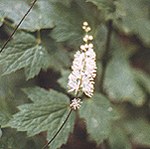|
|
The Eclectic Physician
Medicinal Herb Monographs
Black Cohosh
Botanical Name
Cimicifuga racemosa
|

Cimicifuga racemosa
(Black Cohosh)
|
The information on this page compiled by
Beth Burch N.D.
Index
(click on the keywords)
Introduction
Black Cohosh is a Native American remedy used for the treatment gynecological
complaints and even for snakebite. Kingís American Dispensatory recommends
it for rheumatism and neuralgia, muscle pain, menstrual cramps, headache
and fever. Recent European studies have demonstrated its value in the treatment
of menopausal symptoms including hot flashes, vaginal dryness and insomnia;
its effects being comparable to estrogen therapy for these symptoms.
[ Back to the Index. ]
Description
-
Black Cohosh is a member of the Ranunculaceae or Buttercup family and is
native to the deciduous forests of eastern North America. It is a perennial
herb, growing up to 5 feet tall with a leaf in three parts and a long raceme
of delicate white flowers. It is easy to grow and makes a nice garden plant
under a deciduous tree, blooming from June through August. The root and
rhizome are used in medicine.
[ Back to the Index. ]
Constituents
-
Triterpene glycosides including actein and 27-deoxyactein
-
Phenylpropane derivatives
-
Isoflavones including formononetin
-
Resins
-
Tannins
[ Back to the Index. ]
Action/Effects
-
Antispasmodic
-
Emmenagogue (promotes menstruation)
-
Binds to estrogen receptors (5)
-
Decreases LH (luteinizing hormone) secretion (4)
[ Back to the Index. ]
Conditions used
for
-
Menopausal symptoms including hot flashes, vaginal dryness, insomnia and
depression (1,2,3,4)
-
Menstrual cramps
-
Neuralgia
-
Muscle pain
[ Back to the Index. ]
Dosage
-
Dried root- 250 mg two to three times a day
-
Liquid extract- 1/2 teaspoon two to three times a day
-
Dry extract assayed to 27-deoxyactein- 40 mg twice a day
[ Back to the Index. ]
Side Effects
-
Stomach upset
-
Decreased blood pressure
-
Severe headache, vomiting and dizziness in large doses
[ Back to the Index. ]
Contraindications
[ Back to the Index. ]
Interactions
with medications
-
Donít combine with estrogen replacement therapy or antihypertensive medications
without a physicianís advice
[ Back to the Index. ]
Use in
pregnancy & lactation
-
Should not be used in pregnancy due to its uterine stimulant effects
[ Back to the Index. ]
References
1. Lieberman S, A review of the effectiveness of Cimicifuga
racemosa (black cohosh) for the symptoms of menopause, J Womens Health
1998;7(5):525-9
2. Liske E, Therapeutic efficacy and safety of Cimicifuga racemosa
for gynecologic
disorders, Adv Ther 1998;15(1):45-53
3. Lehmann-Willenbrock E et al, Clinical and endocrinologic studies
of the treatment of ovarian insufficiency manifestations following hysterectomy
with intact adnexa, Zentralbl Gynakol 1988;110(10):611-8
4. Duker EM et al, Effects of extracts from Cimicifuga racemosa on
gonadotropin release in menopausal women and ovariectomized rats, Planta
Med 1991;57:420-24
5. Jarry H et al, Studies on the endocrine effects of the contents
of Cimicifuga racemosa, 2. In vitro binding of compounds to estrogen receptors,
Planta Med 1985;51:316-19
[ Back to the Index. ]
* The information presented in this web site is intended to inform and educate.
It is not intended replace a qualified medical practitioner to diagnose or treat medical conditions.
|
|

